Guest Writer: Mayu Miller of Viña Franca Recounts Her Visit to Succés Vinícola
We asked Mayu Miller, our partner at Viña Franca, to write about Albert Canela and Mariona Vendrell of Succés Vinícola, as well as what it feels like to visit them at their winery in Conca de Barberà.

Celler Succés Vinícola is located in the DO Conca de Barberà, found in the Tarragona province of Catalonia . For many years, this area hadn’t been famous for its viticulture or wines, but recently, it has become one of the most trendy spots for natural wine fans.
“Conca” means depression in English. The area is surrounded by high mountains and is next to the famous DOQ Priorat. The Francoli river runs through the area. Conca de Barberà formerly benefitted from a strategic location on the commercial trade route between France and Castilla, and it is home to the famous castle “Castell de Montblanc,” where the legend of St. George and the Dragon was born.
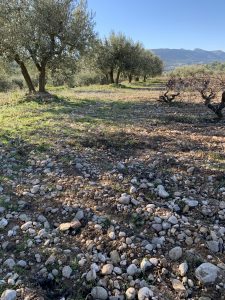
Cistercian monks originally brought winemaking to Conca. They came from France and traveled to Castilla y León through Conca, Montsant, and Priorat. The abundance of religious buildings in the area testifies to the importance of Conca de Barberà during the Medieval era. In spring and autumn, Conca is laden with mist, as if it were covered by the smoke of a dragon.
The river Francoli feeds from water in the high mountains, then arrives and accumulates in Conca. The soil is clay-heavy with some calcareous stones, which renders it ideal for viticulture. The native varieties of Conca are Macabeo, Parellada, and Trepat, which is used to make pale rosé Cava.
The area has been one of the main grape suppliers to big Cava makers for a long time. Farmers used to spray chemical nutrition and water in the vineyards to grow huge amounts of grapes.
In order to maintain their family business, grape growers had to produce tons of fruit, as the price proposed by the local cooperatives is so miserably low. Some of the coops have built very beautiful modernist buildings. Albert says that the cooperatives are still very powerful in Conca, and some old people think that selling grapes to a private winemaker is a sin.
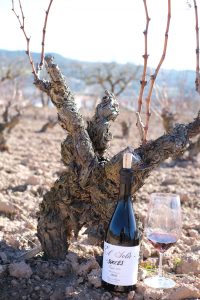
Mariona and Albert first met in the winemaking school in Siurana in Priorat. Albert is the son of grape growers with a long history in Conca, who used to sell their organic grapes to big Cava companies. Early in her life, Mariona wanted to be a veterinarian, but ultimately decided to pursue winemaking instead.
In 2011, Mariona and Albert began producing wine together with the economic support program of DO Conca de Barberà. This “incubator program” allows entrepreneur winemakers to rent a space in the oldest cooperative for a very good price. That cooperative is located in front of the plot of Parellada for Experiencia, and was their home for the first few years when they started making wine.
We normally start our visit at the plot for “Experiencia Parellada.” The wine is a blend of two types of Parellada: 50% skin macerated and 50% direct pressed. They chose the name “Experiencia” (Experience) because they had never made white wine at school in Siurana.
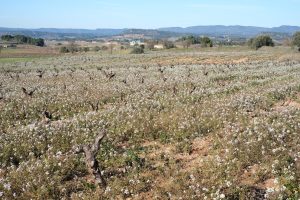
Visiting their vineyards is like seeing the anatomy of their wine. The nature of Conca is so untouched, and all of the vineyards are covered with green grass and wildflowers in the fields between the rows. The area is full of light and soft winds blow gently through the vines. You can smell notes of green herbs, white flowers, and ripe yellow stone fruit. They practice chemical-free, hands-off farming to keep the balance in the soil and vines. I can see the flavor of Experiencia Parellada in my eyes.
Next stop is the plot of “El Pedregal,” which is very special. The soil is covered with calcareous stones and the plot is surrounded with olive trees. It looks like the trees are protecting the plot. You feel silence and clean air. The calcareous soil gives vibrant acidity to this wine.
Parellada is a Catalonian grape that no one really gives any special attention to. We say that the personality of Parellada is floral and fresh. It’s always thought of as the supporting actor in a Cava blend. But El Pedregal has a strong personality and is complex.
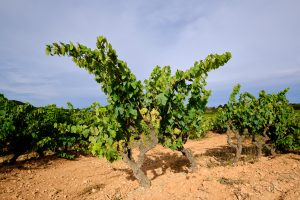
What I enjoy most about visits to see Mariona and Albert is getting lost amongst very, very old Trepat vines. One plot called “El Sola” was planted in 1900. I get emotional whenever I see the plot of Cabernet Sauvignon that Albert’s father planted over 25 years ago. He chose the variety simply because he loves it. Albert’s father carefully selected the very best plot, which is north-facing and cultivated at a high altitude in Conca, as this grape is native to the Atlantic climate.
The average age of Albert and Mariona’s vineyards are old. Most are over 40 years. They are all well balanced because Mariona, Albert, and their family look after each vine. They stretch their wrinkled branches to the blue sky. Recently, Mariona and Albert found some plots of very old Trepat that had been completely abandoned. They are recovering them by themselves. Their aim is to preserve what you see now for the future. Every corner has a special meaning, and they are so happy and confident to show us their new ideas through their wines.
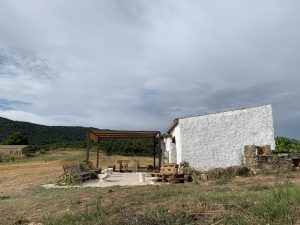
Their cellar is in a small industrial area in the village of Pira. There is nothing very glamorous or modernist to see here, but they transformed their space into a very practical cellar with a lot of love and DIY spirit. In 2020, they set up a “chiringuito” (a small bar on the beach) in the vineyards to receive visitors, which they decorated by hand with old farming tools. Mariona and Albert work equally together. I love to see how they divide their tasks and support each other. They are partners, work colleagues, and above all, share the same passion and spirit.



